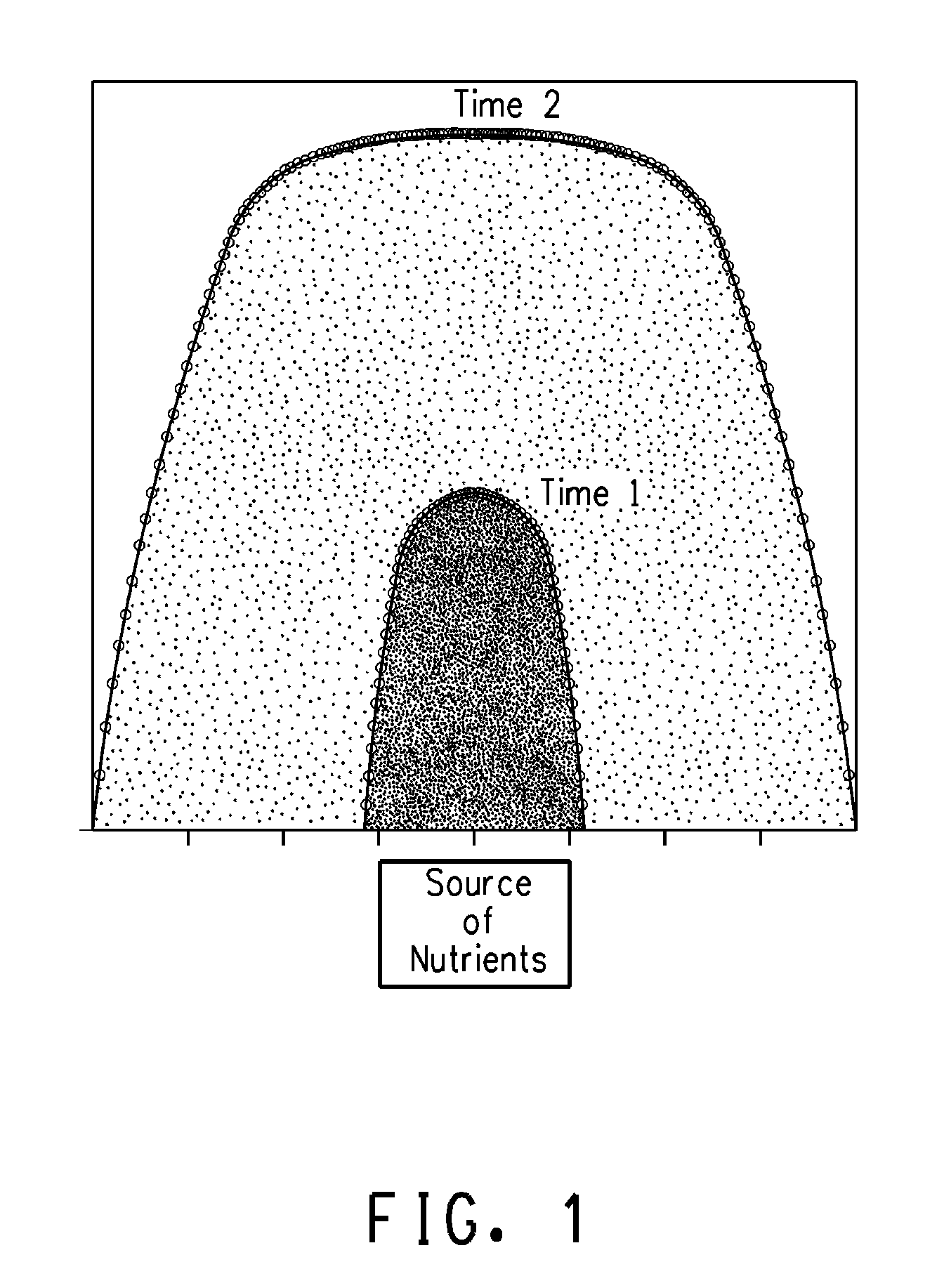Controlling bioavailability of nutrient additions in subsurface formations
a technology of subsurface formation and bioavailability, which is applied in the direction of biocide, sealing/packing, and well accessories, etc., can solve the problems of inability to easily recover by conventional primary and secondary means, unable to control subterranean process, and essentially immobile, so as to prevent microbial growth
- Summary
- Abstract
- Description
- Claims
- Application Information
AI Technical Summary
Benefits of technology
Problems solved by technology
Method used
Image
Examples
example 1
Controlled MEOR Activation
High Concentrations of Growth-Supporting Nutrients are Inhibitory to Oil Well-Associated Microbes
[0085]The purpose of this Example was to demonstrate that high concentrations of nutrients could inhibit microbial growth. Pseudomonas stutzeri strain LH4:15, ATCC PTA-8823 which is found in oil wells on the North Slope of Alaska, was used as the test strain in this Example. The nutrient medium described above supported aerobic growth at 30° C. Additional potential microbial nutrients were added at various concentrations as outlined in Table 1. Growth was monitored visually with positive growth indicated by moderate to heavy turbidity. As shown in Table 1, although sodium nitrate and urea, commonly used nitrogen sources for microbial growth, were permissive for growth at low concentrations, at ≧100 g / L for sodium nitrate and ≧50 for urea, microbial growth was inhibited. Similarly, a variety of organic compounds that are potential growth substrates at lower conce...
example 2
Industrial Preservatives Inhibit Oil Well-Associated Microbes
[0086]The purpose of this Example was to demonstrate that industrial preservatives could inhibit growth of microorganisms associated with oil wells. Pseudomonas stutzeri strain LH4:15 (ATCC PTA-8823) was grown as outlined in Example 1. Various preservatives commonly used in the food, cosmetic, and water treatment industries were tested for their inhibitory effect at various concentrations (Table 2). Growth was monitored visually and positive growth was indicated by moderate to heavy turbidity. As shown in Table 2, with the exception of phenol, the commercial preservatives were effective at preventing growth of the test strain when present at 1 g / L or greater. Thus, these chemicals offer another option for controlling microbial growth. Their advantage over the nutrients used in Example 1 is that they could be used at a much lower concentration compared to those required for the nutrients in Example 1.
TABLE 2Growth response ...
example 3
Determination of Biocidal Versus Biostatic Inhibition
[0087]Examples described above demonstrate that high concentrations of nutrient salts or organic nutrients and industrial preservatives, will inhibit growth of oil well-associated microbes on nutrient mixtures that typically support growth. The nature of this inhibition, whether bacteriocidal (killing) or bacteriostatic (slowing microbial growth), is important to optimizing the activation of MEOR processes within the oil formation or bioremediation within the contaminated subsurface formation. The purpose of this Example was to demonstrate whether growth inhibition was due to bacteroicidal or bacteriosatic effects of the inhibitory compounds used. A number of inhibitory formulations, which mimic formation conditions under anaerobic conditions, were therefore tested.
[0088]The anaerobic growth and survival was tested as outlined above. The inhibitors were added to the 20 ml crimp-capped anaerobic vials at various concentrations (Tab...
PUM
| Property | Measurement | Unit |
|---|---|---|
| porosity | aaaaa | aaaaa |
| temperature | aaaaa | aaaaa |
| concentrations | aaaaa | aaaaa |
Abstract
Description
Claims
Application Information
 Login to View More
Login to View More - R&D
- Intellectual Property
- Life Sciences
- Materials
- Tech Scout
- Unparalleled Data Quality
- Higher Quality Content
- 60% Fewer Hallucinations
Browse by: Latest US Patents, China's latest patents, Technical Efficacy Thesaurus, Application Domain, Technology Topic, Popular Technical Reports.
© 2025 PatSnap. All rights reserved.Legal|Privacy policy|Modern Slavery Act Transparency Statement|Sitemap|About US| Contact US: help@patsnap.com



